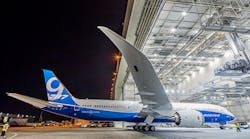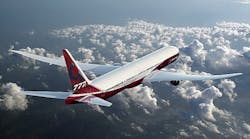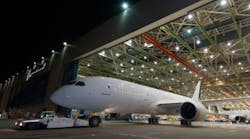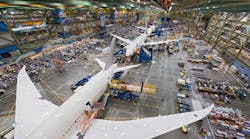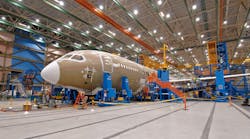Boeing Commercial Airplanes has assigned the assembly work for the newest jets in the 787 family exclusively to the North Charleston, S.C., plant it established in 2004. The move may be controversial because of the International Association of Machinists union’s previous contention, on behalf of its members employed at Boeing’s Everett, Wash., assembly plant, that that the South Carolina operation was developed in order to avoid building the jets at their location.
The union sued Boeing through the National Labor Relations Board, contending retaliation (versus IAM workers in Washington state) for building the new plant in a “right to work” state. Boeing and the IAM later settled the dispute, and Boeing agreed to build its 737MAX jet series at the Everett plant.
"We looked at all our options and found the most efficient and effective solution is to build the 787-10 at Boeing South Carolina," stated vice president and general manager Larry Loftis, of BCA’s 787 program. "This will allow us to balance 787 production across the North Charleston and Everett sites as we increase production rates. We're happy with our growth and success in South Carolina, and the continued success at both sites gives us confidence in our plan going forward."
The 787-10 is the largest jet in the 787 series, nearly 225 feet long, with a range up to 7,000 nautical miles. The length of the design means that the midbody assembly is too long to be transported efficiently from North Charleston (where systems integration work is done) to Everett for final assembly.
Boeing also noted that manufacturing the 787-10 in North Charleston will take advantage of that plant’s available capacity. It already plant assembles and installs systems for 787 aft fuselage sections, and joins and integrates midbody fuselage sections.
There are three design variants of the Dreamliner, currently: the 787-8 (161 jets delivered to-date), 787-9 (debuted in 2013), and 787-10. Assembly of the first 787-10 is scheduled for 2017.
The 787 Dreamliner is Boeing’s standard for wide-body twin-engine aircraft, with long range and carrying capacity for 210 to 330 passengers. Boeing also claims it is its most fuel-efficient commercial jet, with a structure based on a large volume of composite materials helping to reduce fuel consumption by up to 20% versus similar-size jets. A more advanced aerodynamic design than previous jets, more-electric systems, and modern engines add to the 787’s appeal to airlines.
Dreamliners are assembled at three production lines: two in Everett (including a temporary surge line) and one in South Carolina. The current integrated production system yields 10 airplanes per month, but Boeing has said its 787 production rate will increase to 12 jets per month in 2016 and 14 jets per month by 2020.
Boeing emphasized it would continue assembling both the 787-8s and 787-9s in Everett, and North Charleston.
Everett will continue assembling seven airplanes per month, and Boeing South Carolina will increase from three 787s per month now to five per month in 2016, and seven per month by 2020.
